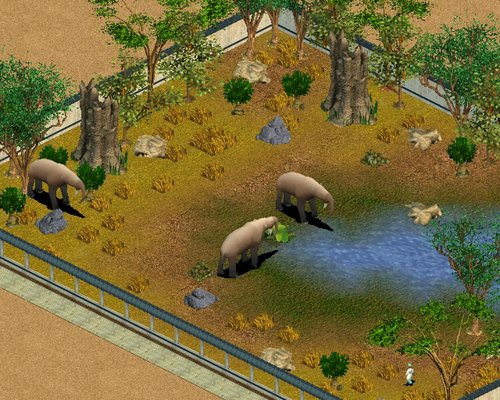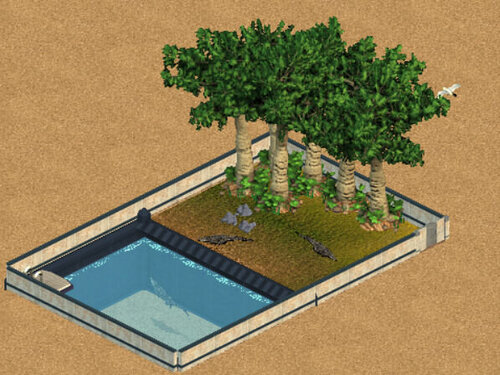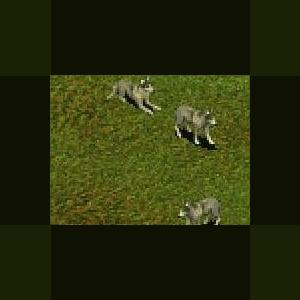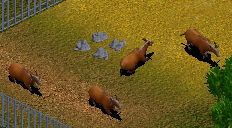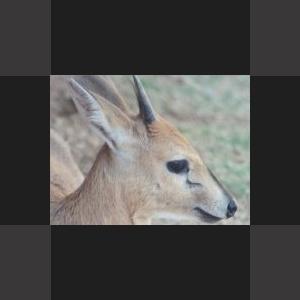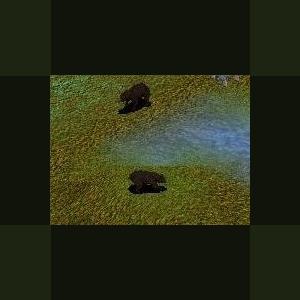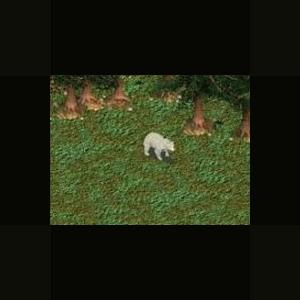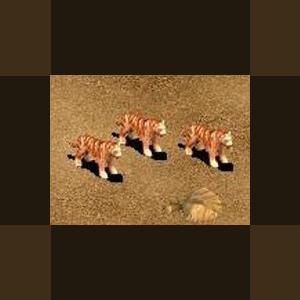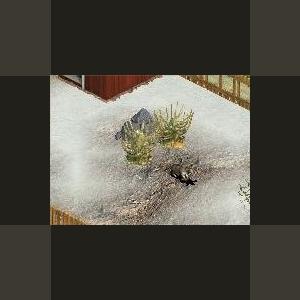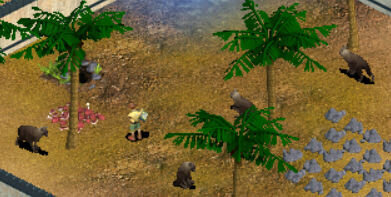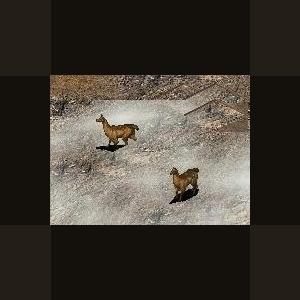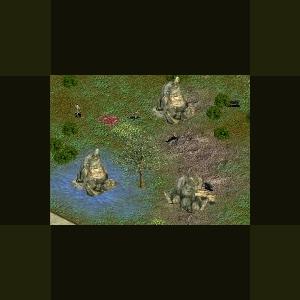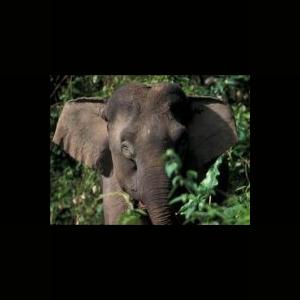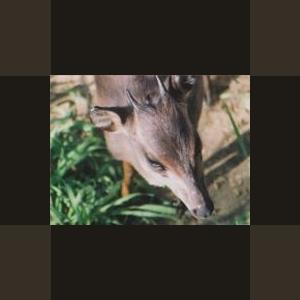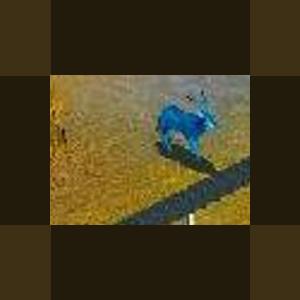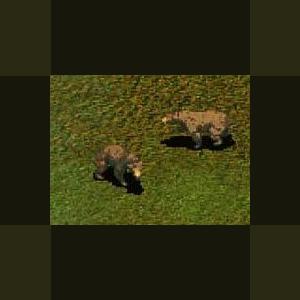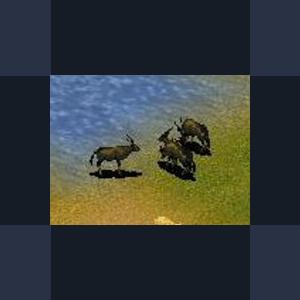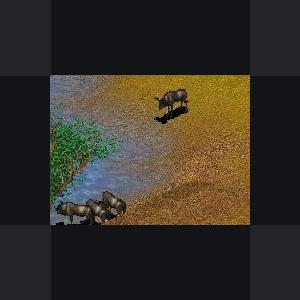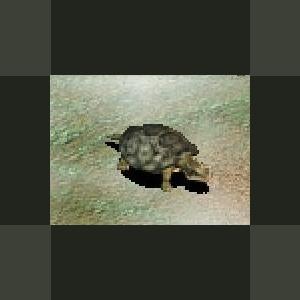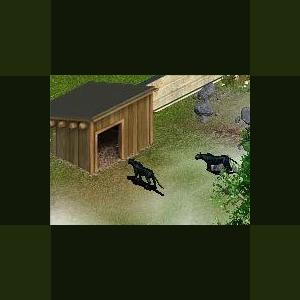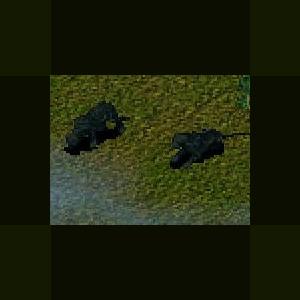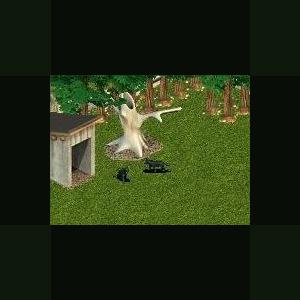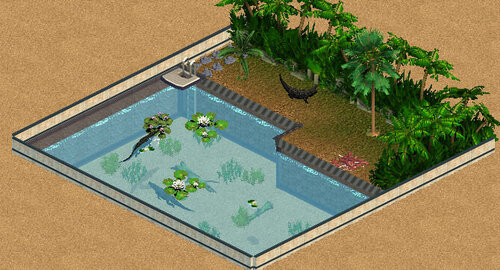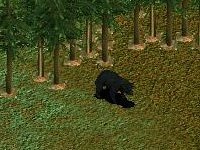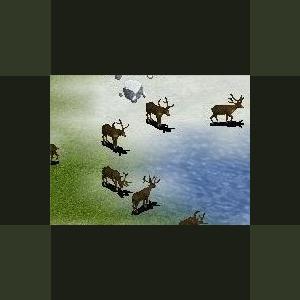279 files
-
Deinotherium
By Khaydar
Adds the deinotherium for your zoos. Based on the species D.giganteum from the Miocene
Here's some data:
Number of animals:1-6
Animal compability:none (must be kept without other species)
Requires a mate: No
Needs toy: No
Exhibit size: 100 sq
Terrain: 40 savannah
20 rainforest
10 freshwater
30 dirt
for a 100 sq exhibit
Shelter: Both elephant shelters
Foliage: 25 sq
Rocks: 4 sq
Biomes: Compatible with deciduous, savannah and tropical foliage and rocks
Extra: Can also be kept with strong zoo tycoon fences for more realism.
Requires: Dinosaur Digs Expansion to work.
257 downloads
0 comments
Updated
-
Cuban Crocodile
By Khaydar
Adopt a Cuban Crocodile (Crocodylus rhombifer) for your zoos.
Cuban Crocodile description:
Minimum happiness needed for chance of breeding: 95.
Liked foliage:
Water Reed, Water Lily, Llala Palm Tree, Kapok Tree
Liked rock:
Large Rock, Small Rock - Medium, Small Rock - Small
Number of animals allowed per exhibit: 2-3 with 20 squares each.
A suitable exhibit for 2 of this animal has 40 squares containing terrain of:
20 Fresh Water, 4 Dirt, 6 Savannah Grass, 10 Rainforest Floor
using 6 grid squares filled with 6 Kapok Trees most liked plant
and using 3 Small Rock - Small most liked rock.
Other liked items:
Tank Filter (MM)
Credits to Hendrix and Zerosvalmont for the model and mesh
Made by Khaydar
152 downloads
- khaydars animal
- living animal
- (and 1 more)
0 comments
Updated
-
Coyote by LAwebTek
By Guest
Coyote
Author: LAwebTek
The name coyote is a Spanish alteration of the original Aztec name coyotl. The Latin name Canis latrans, meaning barking dog, was given to it by Thomas Say, who published a description of the species in 1833. Since 1967, its official name in Canada, in both English and French, has been coyote. In some parts of Canada coyotes are called "brush wolves." Wolves are much larger and characteristically hunt in packs.
Slimmer and smaller than the wolf, the male coyote weighs from 9 to 23 kg, has an overall length of 120–150 cm (including a 30–40 cm tail), and stands 58–66 cm high at the shoulder. The female is usually four-fifths as large.
The coyote's ears are wide, pointed, and erect. It has a tapering muzzle and a black nose. Unlike most dogs, the top of the muzzle on coyotes forms an almost continuous line with the forehead. The yellow, slightly slanting eyes, with their black round pupils, give the coyote a characteristic expression of cunning. The canine teeth are remarkably long and can inflict serious wounds. The neck is well furred and looks oversized for the body. The long tongue often hangs down between the teeth; the coyote regulates its body temperature by panting.
The paw, more elongated than that of a dog the same size, has four toes with nonretractable claws. The forepaws show a rudimentary thumb, reduced to a claw, located high on the inner side. The claws are not used in attack or defence; they are typically blunted from constant contact with the ground and do not leave deep marks.
The fur is generally a tawny grey, darker on the hind part of the back where the black-tipped hair becomes wavy. Legs, paws, muzzle, and the back of the ears are more yellowish in colour; the throat, belly, and the inside of the ears are whiter. The tail, darker on top and lighter on the underside, is lightly fawn-coloured towards the tip, which is black.
The coyote's fur is long and soft and well suited to protect it from the cold. Because it is light-coloured in winter and dark in summer, it blends in well with the seasonal surroundings.
Like all Canidae, the coyote has, at the root of the tail, a gland that releases a scent. Such glands also exist on other parts of the body. Scent glands often become more active when the animals meet. The coyote's urine has a very strong smell and is used to mark out its territory. Trappers use the secretions when they set traps to attract the coyote.
European settlers found the coyote on the plains, prairies, and deserts of central and western North America. It appeared to prefer open or semi-wooded habitats. However, about the turn of the century, the coyote began a dramatic range expansion that is still in progress.
In Canada, the coyote still inhabits its traditional habitats, the aspen parkland and short- and mixed-grass prairie in the three prairie provinces. However, it has spread north into the boreal forest, west into the mountains, and east into Ontario, Quebec, and the Atlantic provinces. The progress of this dramatic "invasion" has been carefully charted; for example, coyotes established themselves in Ontario about the turn of the century, in Quebec in the 1940s, and in New Brunswick and Nova Scotia in the 1970s. Most astonishing of all, coyotes have recently been discovered in western Newfoundland, apparently having crossed on the ice from Nova Scotia.
The reasons for the coyote's expansion are not fully understood but probably include several conditions created by people: the clearing of forests, provision of carrion from domestic livestock, and the removal of the wolf. The mosaic of grassy fields, brush, and woodlots created by farming areas once covered with unbroken forest has provided attractive habitat for the coyote, as well as several other species like the red fox and raccoon. The coyote has learned to scavenge the carcasses of domestic livestock, much as it still scavenges the carrion left by wolves, where the two species occur together. The removal of the wolf in some areas has meant more to coyotes than the absence of a feared predator. It has meant less competition for many prey animals. For example, in winter, when snow conditions are right, coyotes can themselves kill large ungulates (hoofed mammals), such as deer, that multiply in the absence of wolves. Also, in hard winters, these swollen deer populations run out of food, the deer die of starvation, and the resident coyotes enjoy a food bonanza.
Like the wolf, the coyote's best known trait is its yelping and howling cry, a sequence of high-pitched, ear-piercing bayings. The coyote can also bark, growl, wail, and squeal. Although often silent in daytime, it may make itself heard at any time from sunset to sunrise, and especially at dusk and dawn.
Should there happen to be several coyotes in the same vicinity, the howling of one triggers that of the others, resulting in an impressive concert. Two coyotes howling in unison can create the illusion of a dozen or more. The coyote can also sound farther away than it is.
Scientists are intrigued by the coyote's howling, which seems to be a means of communication. The cry invariably brings a reply, then a sort of commentary followed by another prolonged cry, and finally a volley of raucous yelpings. Is it a cry for food, for a mate, or a proclamation of its territorial claims? Is it just an expression of joy at being alive or of sociability? The coyote is fond of playing with other coyotes, even with its prey before devouring it.
The coyote's senses of hearing and smell are so well developed that a sudden odour or noise can make it change its course in mid-step. Its agility in this respect is incredible, perhaps unique in the animal kingdom.
The coyote is a remarkably hard runner, galloping along at 40km per hour, but capable of reaching 64km per hour. Greyhounds, well known for their speed in running, can catch up with coyotes, but may require quite a long time to do so. Should the need arise, the coyote can swim well.
Coyotes appear to be monogamous, and couples may remain together for several years. Both sexes can breed at one year of age under good conditions, although both sexes usually breed somewhat later in life. During the mating season, males solicit the females' favours. The mating takes place mainly during February-March; gestation lasts from 60 to 63 days.
The coyote uses a den for the birth and early care of its cubs. It may be located at the base of a hollow tree or in a hole between rocks, but most often consists of a burrow in the soil. The coyote prefers to den on the banks of a stream or the slopes of a gorge and usually chooses a concealed spot. It often enlarges an abandoned marmot or badger burrow. The female may prepare alternative lodgings to enable her family to move to another refuge should trouble occur. Earth, pushed toward the entrance, is piled up onto a fan-shaped heap, which the animal skirts when going in or out. The same shelter may be used for several years.
Before the female gives birth, or "whelps," the den is thoroughly cleaned. On average, she bears three to seven pups, covered with fine brown fur, whose eyes remain closed for the first eight or nine days.
The male prowls around and brings food to the entrance as long as the pups do not venture from the den. The adults remove refuse as it accumulates. Weaning begins about one month after birth; thereafter the adults regurgitate half-digested food for the pups.
At about three weeks of age, the pups begin to romp around under the adults' watchful supervision, first inside the shelter, then outside. Should some enemy come too close, the adult utters a special warning bark, then lures the enemy away.
Later, the adults teach the pups how to hunt. When fall comes, the young coyotes may leave their parents to claim their own territory. If there is an abundant food supply, pups may stay with the adults to form packs, or clans.
Although primarily a flesh-eater, the coyote will eat just about anything available. Rabbits and hares are typically dietary staples, as are small rodents. Blueberries and other wild fruits are commonly eaten, in quantity, in summer and fall. Coyotes also eat insects, for example, grasshoppers, when they become available. Where coyotes and wolves live near each other, coyotes scavenge from wolf kills. Carrion from livestock and other sources is important too, especially in winter. Coyotes commonly prey on deer fawns in spring and summer; however, they may also prey on adult-sized deer and other large hoofed mammals during certain snow conditions in winter. Coyotes prey on domestic sheep when they are available, and may take beef calves and domestic poultry, too.
Coyotes have flexible social behaviour and adjust their hunting methods to the prey size and food sources available. Coyotes often hunt small prey animals singly, whereas they hunt large prey and defend large carcasses in groups.
The coyote has numerous foes. Chief among these are people; in some areas, 90% of the deaths of coyotes older than five months are caused by people, whether purposefully with guns, poison, and traps, or accidentally with vehicles and farm machinery. Wolves, black bears, mountain lions, and eagles all prey on the coyote. A Iynx can kill a coyote but will not attempt to do so unless the odds are in its favour.
Parasites and diseases can sometimes lead to death. Common are outbreaks of sarcoptic mange, an infestation by microscopic mites that causes thickening of the skin, loss of hair, and itching. Heartworm and hookworm are other common parasites of coyotes. Coyotes may also suffer from diseases such as distemper, canine hepatitis, rabies, and parvo virus.
2003 LAwebTek
Updated 2010-10-30
Just to save space with less in zip and smaller image.
Nothing new.
Updated 4 March 2011 by Fern to reinstate the file that was updated in 2009 with the following updates:
UPDATED July 25, 2009 to fix the following:
- Made small correction to the .uca
- As there are multiple coyotes with the same ztd name, the ztd name has been CHANGED from coyote.ztd to coyote_LA.ztd.
560 downloads
0 comments
Updated
-
Congo Buffalo
By Khaydar
Adopt a Congo Buffalo (Syncerus caffer nanus) for your zoos
Congo Buffalo description:
Minimum happiness needed for chance of breeding: 90.
Liked foliage:
Elephant Ear Tree
Liked rock:
Large Rock, Small Rock - Medium, Small Rock - Small, Rainforest Rock
Stone Ruins
Animal can jump.
Number of animals allowed per exhibit: 3-15 with 20 squares each.
A suitable exhibit for 3 of this animal has 60 squares containing terrain of:
24 Rainforest Floor, 6 Dirt, 18 Savannah Grass, 12 Fresh Water
using 7 Elephant Ear Tree most liked plant
and using 5 Small Rock - Small most liked rock.
Preferred shelter: Large Stable.
Credits to DutchDesigns for the model and mesh
Made by khaydar
213 downloads
- living animal
- bovid
- (and 1 more)
0 comments
Updated
-
Common Duiker by Jordan
By Guest
Body Length: 80-115 cm / 2.6-3.8 ft.
Shoulder Height: 45-60 cm / 1.5-2 ft.
Tail Length: 10-20 cm / 4-8 in.
Weight: 10-20 kg / 22-44 lb.
The coat is generally pale reddish-brown to grizzled gray, depending on the geographical location. The undersides are whitish, while the muzzle, nose bridge, and forelegs are black. The short tail is black on the top, contrasting sharply with the fluffy white underside. The long, pointed ears are separated by a tuft of hair on the forehead. Females are usually larger than males. The sharply pointed horns are usually found only in males and grow 7-18 cm / 3-7 inches long. The horns are more vertically oriented than in other duiker species, due to the more open habitat.
Gestation Period: 6-7 months.
Young per Birth: 1
Weaning: 2 months.
Sexual Maturity: Females at 8-10 months, males at 12 months.
Life span: Up to 14 years.
After birth, the young lie up in dense cover for a number of weeks.
Feeding predominantly from dusk until dawn, the gray duiker rests in favourite hiding places in scrub or grass during the day. This small antelope has exceptional speed and stamina, and is usually able to outrun dogs that chase after it. The home ranges of individuals of the same sex rarely overlap. However, there is substantial common land in the ranges of individuals of the opposite sexes. Males are territorial, marking their defended areas with preorbital secretions and attacking other males that intrude. The favourite resting place of these males is a high spot overlooking their territory. In favourable areas there are approximately 2 animals per square kilometer. Juveniles make a loud bleat if caught, which brings the parents running.
Family group: Usually solitary, although pairs are occasionally sighted.
Diet: Tree and bush foliage, fruits, seeds, occasionally carrion.
Created by Jordan, Zoo Tek Designer, 2005
Inspired by the Zoo Tycoon Brains Trust at Zoo Tek
Updated 2010-10-30
Just to save space with less in zip and smaller image.
Nothing new.
368 downloads
0 comments
Updated
-
Cinnamon Bear by Ghirin
By Guest
A beautiful color phase of the black bear that will look great in any zoo.
Cinnamon bears prefer to live alone or in small groups.
Cinnamon bears like to sleep in rock caves.
Updated 2010-10-30
Just to save space with less in zip and smaller image.
Nothing new.
250 downloads
0 comments
Updated
-
Chinese White Bear by Ghirin
By Guest
Chinese White Bear
Author: Ghirin
The Chinese White Bear is a legendary animal from the Hubei province of China. It is pure white and is said to live in the Shennongjia forests of that region. It might be a white phase population of Asian brown or black bears.
Created by Ghirin 2005
Updated 2010-10-30
Just to save space with less in zip and smaller image.
Nothing new.
Updated by JohnT with corrections and some clean up in deleting unneeded pal files and uca stuff!
New uca date Aug 20 2012
334 downloads
0 comments
Updated
-
Caspian Tiger by Moondawg
By Guest
The Caspian tiger or Persian tiger (Panthera tigris virgata) was the westernmost subspecies of tiger.
Found in Iran, Iraq, Afghanistan, Turkey, Mongolia, Kazakhstan, Caucasus, Tajikistan, Turkmenistan and Uzbekistan until it apparently became extinct in the late 1950s, though there have been several alleged sightings of the tiger.When extant, the Caspian tiger was the third largest of the known subspecies of tigers. The body of this subspecies was quite stocky and elongated with strong legs, large, wide paws, and unusually large claws. The ears were short and small, and gave the appearance of being without hair on the tips. Around the cheeks, the Caspian tiger was generously furred and the rest of its fur was long and thick. The coloration resembled that of the Bengal Tiger. The skin specimen in the British Museum has a yellow-gold color over the back and flanks, while the sides of the body are lighter than the back and the striping also varies from light to dark brown. The chest and abdomen is white with yellow stripes, while the facial area is yellow with brown stripes on the forehead and obvious white patches around the eyes and cheeks. Outer portions of the legs are yellow and the inner areas white. The tail of this subspecies is yellow and has yellowish white stripes. In winter, the hair of the Caspian tiger was very long, and the tiger had a well-developed belly mane and a short nape mane. Male Caspian tigers were very large and weighed 169-240 kg. Females were not as large, weighing 85-135 kg.
Work with the preserved remains of the Caspian tiger has shown that it shares a comparatively recent common history with the Siberian tiger (P. t. altaica), at least when it comes to maternal or mitochondrial lineages. It appears that tigers colonized Central Asia at most 10,000 years ago, and the modern Siberian stock may be the result of a few Caspian tigers subsequently wandering east via North Asia.
Until the 19th century, Caspian tigers still inhabited wide spaces of Western and Central Asia. In the mid-1800s, Caspian tigers were killed 180 km northeast of Atbasar, Kazakhstan and near Barnaul, Russia (Ognev 1935, Mazák 1981). The only reported Caspian tiger from Iraq was killed near Mosul in 1887 (Kock 1990). In 1899, the last Caspian tiger near the Lop Nur basin in Xinjiang, China, was killed (Ognev 1935). Caspian tigers disappeared from the Tarim River basin in Xinjiang, China, by the 1920s. (Nowell & Jackson 1996) In 1922, the last known tiger in the Caucasus region was killed near Tbilisi, Georgia, after killing domestic livestock (Ognev 1935). The last record of the Caspian tiger on the Ili River, their last stronghold in the region of Lake Balkhash, Kazakhstan, dates to 1948. (Nowell & Jackson 1996)
The Russian government had worked heavily to eradicate the Caspian tiger during planning a huge land reclamation program in the beginning of the 20th century. They considered there was no room for the tiger in their plans and so instructed the Russian army to exterminate all tigers found around the area of the Caspian Sea, a project that was carried out very efficiently. Once the extermination of the Caspian tiger was almost complete, the farmers cleared forests and planted crops like rice and cotton. Due to intensive hunting and deforestation, the Caspian tiger retreated first from the lush lowlands to the forested ranges, then to the marshes around some of the larger rivers, and finally, deeper into the mountains, until it almost certainly became extinct. The last stronghold of the Caspian tiger in the former Soviet Union was in the Tigrovaya Balka area, which is situated in Tajikistan in the undercurrent of Vakhsh River between the Piandj and Kafirnighan at the board of Afghanistan. Though the tigers were reported as being found here until the mid-1950s, the reliability of these claims is unknown.
Updated 2010-10-30
Just to save space with less in zip and smaller image.
Nothing new.
529 downloads
0 comments
Updated
-
Caribou by Hersheyqwert
By Guest
Caribou by Hersheyqwert
Recolor of the Reindeer. The animations has been deleted when they "flew" or anything else with the sparkles. They need snow, grey stone, grass, freshwater, and some dirt in their exhibits. They like a stable and some elevation. They like both the sage bush and tundra plants.
Updated 2010-10-30
Just to save space with less in zip and smaller image.
494 downloads
0 comments
Updated
-
Brown Hyena by Khaydar
By Khaydar
Adopt a Brown Hyena (Hyaena brunnea) for your zoos.
Animal guide:
Minimum happiness needed for chance of breeding: 90.
Liked foliage:
Savannah foliage, desert foliage
Liked rock:
Savannah rocks, desert rocks, small, medium, large rocks
Animal can jump.
Number of animals allowed per exhibit: 2-8 with 20 squares each.
A suitable exhibit for 2 of this animal has 40 squares containing terrain of:
18 Sand, 8 Savannah Grass, 4 Dirt, 8 Brown Stone, 2 Fresh Water
using 2 grid squares filled with 4 Palm Tree most liked plant
and using 16 Small Rock - Small most liked rock.
Of the 40 squares, 1 nonadjacent squares should be elevated.
Preferred shelter: Large Burrow.
Updated: 19 January 2021 by fern to change the ztd and zip names (to avoid a file name conflict), and to compress the ztd better. None of the files inside the ztd were changed.
213 downloads
- living animal
- khaydars animal
- (and 1 more)
0 comments
Updated
-
Brown Alpaca by Ghirin
By Guest
Brown Alpaca by Ghirin
The alpaca (Lama pacos), a relative of the llama, is a domesticated camelid from the Andes Mountains of South America.
Unlike the llama, the alpaca has been bred for its wool and is much smaller than the llama. The wool of the alpaca is among the finest in the world, bested only by that of the vicuna and certain breeds of goat.
Alpacas come in two wool varieties, suri and huacaya. The wool of the suri alpaca is finer and straighter than that of the huacaya. It falls in locks along the sides of the suri alpaca. The huacaya alpaca is more common than the suri; its wool is crimpy and gives the huacaya a "teddy bear" appearance. The wool of either variety comes in several colors, from white to black.
The peoples of the Andes domesticated the ancestors of the alpaca approximately 5000 years ago and these animals were used as a source of wealth.
*Inspired by the Zoo Tycoon Brains Trust at the Zoo Tek Zoo Tycoon Forums.
References:
http://alpacaplanet....lpacas_FAQ.html
http://www.alpaca.com/thealpaca.cfm
http://www.americasa...outalpacas.html
http://www.llama-llo...id_history.html (excellent picture)
Walker's Mammals of the World, Nowak, 1999.
Updated 2010-10-30
Just to save space with less in zip and smaller image.
153 downloads
0 comments
Updated
-
British Wilderness Pack by G2K
By Guest
This great pack has three animals: the red fox, Black Scottish Cat, and a Scottish Cat, a rock, grass, and gorse.
Scottish Wild Cats are found in the forests and open areas of Scotland and north England.
Red Foxes are found worldwide in a variety of habitats.
Black Scottish wild cats are melanistic forms of scottish wild cats.
Also contains gorse, forest fern and a granite rock.
Updated 2010-10-30
Just to save space with less in zip and smaller image.
24 February 2013 to add the July 2009 update since unfortunately the wrong file was uploaded in 2010 when all files had to be reloaded. The January 2009 update was loaded instead of the July 2009 version.
Updated : Jan 7 2009, to adjust scenery
*UPDATED July 25, 2009 by Genki to fix the following:
- Fixed LCID errors, which can cause some people's games to crash.
- Linked to in-game sounds and removed extra, unneeded sounds.
- Cleaned up .uca and fixed some errors and warnings that were coming up on the .uca checker.
- Foliage (forest fern and gorse) adjusted to make them auto-rotate, and to adjust so that the guests can see over them.
760 downloads
0 comments
Updated
-
Bornean Elephant by Jordan
By Guest
Bornean Elephant
Author: Jordan
http://www.zoo-tek.com/forums/index.php?download=172
Borneo's elephants (Elephas maximus sumatrensis) (Payne et. al. 1985) represent an island population on the perimeter of the distributional range for Asian elephants in Southeast Asia. Their distribution corresponds to the Northeast Borneo Ecoregion of WWF classifications. They are thus likely to be genetically distinct, and may have developed other adaptations from the populations on the mainland and within the central areas of the species' range. Elephants only occur between the Sugut River in north-eastern Sabah and Sembakung River in northern East Kalimantan. Distinct anatomical differences from mainland elephants have prompted some taxonomists to give the Bornean elephant subspecies status (Davies, 1962; Payne et. al. 1985). Despite these differences, often rumoured but never studied, stories persist that Borneo's elephant population may have originated from domesticated elephants released by either the Sultan of Brunei or the Sultan of Sulu, and add a special twist to the mystique of these elephants. The peculiarly restricted distribution on Borneo, the lack of truly fossilised remains and the lack of indigenous names for the species elsewhere on the island, lend credence to this theory but do not confirm it.
Surveys in the early 1990s indicated that Borneo may then have had 1000+ elephants (Dawson, et al., 1996). Recent opportunistic reports indicate that today's population may be higher. There are indications that over the last 15-25 years the elephant population in Sabah has dramatically increased in some localities. Possible reasons are the squeezing and concentration of remaining elephant populations into smaller forest patches due to land use change, and the conversion of primary to secondary forest through commercial harvest of timber, with concomitant alterations of food supply and habitat conditions. However, Borneo's elephants are now coming under very strong extinction pressure. Large-scale conversion of secondary forests to oil palm plantations has begun, and is expected to dramatically increase in the next few years. While elephants do not necessarily require forest to be undisturbed, they do require large tracts of land with plenty of food sources. They readily feed in all kinds of agricultural areas and can cause significant conflicts in areas where their range is fragmented by agriculture. In Sabah, elephants still range over a large connected forest area. Only a few herds are isolated in fragmented, yet still relatively large, forest patches. However, there is a very real danger that the current forest fragments will soon be too small to contain viable populations, and that the large connected forest area will soon be fragmented as planned plantation schemes are carried out. In Sabah, most elephant herds on the border of existing plantation schemes at this time cause little conflict, perhaps indicating that these forest patches are still large enough to supply all the elephants' resource needs. However, the Lower Kinabatangan River, and the Deramakot Forest Reserve much further to the west, are currently developing into major conflict sites. Elephant herd size in this combined area may be up to 500 elephants. The riverine forests of the Lower Kinabatangan, the area's premier remaining elephant habitat, is rapidly being converted to oil palm plantations. The threat of completely disrupting the movements of the resident elephants is very real as the last open habitat "bottle necks" are rapidly being bought up and fenced in by plantations. There are occasional but persistent reports of killings of conflict elephants in the area.
Designed by JordanMK exclusively for Tek Forums.
Updated 2010-10-30
Just to save space with less in zip and smaller image.
444 downloads
0 comments
Updated
-
Blue Duiker by Jordan
By Guest
Body Length: 50-75 cm / 1.6-2.5 ft.
Shoulder Height: 30-40 cm / 12-16 in.
Tail Length: 7-10 cm / 3-4 in.
Weight: 3.8-5.4 kg / 8.4-12 lb.
Females are generally larger than males in this duiker species. The colour of the coat varies with the region from slate grey to grey-brown, with a bluish sheen on the back. The underparts, inner legs, rump, and underside of the tail are whitish. There is a light eye-brow ridge which curves up to the base of the horns, as well as a glandular slit underneath the eye. The horns are strongly ridged and short, growing 2-10 cm / 0.8-4 inches long. The horns are sometimes absent in females, or hidden by the short head crest.
Gestation Period: 7.5 months.
Young per Birth: 1, rarely twins.
Weaning: By 5 months.
Sexual Maturity: Females at 9-12 months, males at 12-18 months.
Life span: 10-12 years.
Kids lie concealed away from the mother for 2-3 months. At this point their coat changes from reddish brown to the grey-blue colour of adults.
The blue duiker is mostly active at night and at dawn and dusk. Bonded pairs patrol their territory, which are 2.5-4 hectares in size, regularly marking them with scent clues from their pedal glands (situated between the hooves), facial glands, and from defecating. Both sexes chase off any intruders, but will remain tolerant of their own young until they reach 18 months of age. The mother and young contact through soft groaning calls, both freezing at the slightest alarm. Males may emit a whistle or a sneezing sound to raise the alarm. Population densities of up to78 per square kilometer have been recorded in Gabon.
Family group: Solitary or in mating pairs.
Diet: Leaves, buds, shoots, grasses, fruit, insects, eggs.
Created by Jordan, Zoo Tek Designer, 2005.
*Inspired by the Zoo Tek Nature Encyclopedia. (www.zoo-tek.com)
Updated 2010-10-30
Just to save space with less in zip and smaller image.
370 downloads
0 comments
Updated
-
Blue Buck Sable Antelope by Sundance
By Guest
Bluebuck Sable Antelope by Sundance
This guy is a real cutie! works with zt, dd , mm and cc.
The early travelers found the blue antelope only in relatively well-watered country, which suggests that, like the roan and sable, it had to drink regularly. Also like the roan and sable, the blue antelope apparently lived in small herds of up to twenty individuals, and it was primarily a grass-eater or grazer that sometimes fed on the same pastures as sheep.
Updated 2010-10-30
Just to save space with less in zip and smaller image.
157 downloads
0 comments
Updated
-
Blond Bear by Ghirin
By Guest
The blond bear is a color phase of the American black bear. This particular color phase is most common in the western portion of North America and is thought to be due to the more open habitat of that region. Brown, black, and cinnamon “black” bears are also found in the same regions as blond bears.
Blond bears have the same habitat needs as regular black bears. It is compatible with black, cinnamon, and glacier phases of the American bear.
Updated 2010-10-30
Just to save space with less in zip and smaller image.
249 downloads
0 comments
Updated
-
Blesbok by Moondawg
By Guest
The Blesbok, or Blesbuck, (Damaliscus albifrons) is a subspecies of the Bontebok and it is purplish antelope with a distinctive white face and forehead.
They are close relatives of the Bontebok and are only found in South Africa (mostly in protected herds). They were first discovered in the 17th century, but it is not known whether this is because they are a relatively new species or because they have been so elusive.
The Blesbok, or Blesbuck, (Damaliscus dorcas phillpsi) is related to the Bontebok (Damaliscus dorcas dorcas) and it is purplish antelope with a distinctive white face and forehead. Its white face is the origin of its name, because ‘bles’ is the Afrikaans word for blaze. Although they are close relatives of the Bontebok and they can interbreed creating an animal known as the Bontebles they do not share habitat, the Bontebok being found in large numbers on from as far south as Eastern Cape, the plains of the Free State and the Transvaal Highveld. They are a plains species and dislike wooded areas. The blesbuck is indigenous to South Africa and are found in large numbers in all national parks with open grasslands. They were first discovered in the 17th century, and were found in numbers so numerous that herds that reached from horizon to horizon where documented
The neck and the top of the back of the blesbuck are brown. Lower down on the flanks and buttocks, the coloring becomes darker. The belly, the inside of the buttocks and the area up to the base of the tail are white. Blesbucks can be easily differentiated from other antelopes because they have a distinct white face and forehead. The legs are brown with a white patch behind the top part of the front legs. Lower legs whitish. Both sexes have horns, female horns are slightly more slender. The blesbok differs from the bontebok by having less white on the coat and the blaze on the face, which is usually divided, their coats are also a lighter brown than that of the bontebok. The length of their horns averages at around 38cm. Male adult blesboks average around 70kg, females average lower, at around 61kg.
Blesboks can be found in open velds and open plains of South Africa. Preferred habitat is open grasslands with water.
Updated 2010-10-30
Just to save space with less in zip and smaller image.
349 downloads
0 comments
Updated
-
Black Wildebeast by G2K
By Guest
Black Wildebeast
Author: G2K
The black wildebeest is dark brown to black in color, males being darker in color than females. Both sexes become lighter in coat color in the summer, and develop shaggier coats in the winter. Like the common wildebeest, Connochaetes taurinus, Connochaetes gnou possesses a bushy beard and mane.
Updated 2010-10-30
Just to save space with less in zip and smaller image.
UPDATED July 25, 2009 by genki to fix the following:
- Fixed LCID error, which can cause some people's games to crash.
- Linked to in-game sounds and removed extra, unneeded sounds.
- Cleaned up .uca and fixed some problems that were coming up on the .uca checker.
Update 8 August 2013 to reupload the updated file because the old file was uploaded in 2010 by mistake.
296 downloads
0 comments
Updated
-
Black Tortoise by Ghirin
By Guest
Black Tortoise by Ghirin
The Black Tortoise is one of the four legendary creatures of China.
The others are the White Tiger, Azure Dragon, and Vermilion Bird. Each animal is associated with a color, season. geographic direction, and element. The Tortoise is associated with black, winter, north, water, and faith.
The Black Tortoise is often encircled by a snake.
Reference:
www.wikipedia.com
http://www.onmarkproductions.com/html/ssu-ling.shtml#turtle
Updated 2010-10-30
Just to save space with less in zip and smaller image.
300 downloads
0 comments
Updated
-
Black Puma by LAwebTek
By Guest
Black Puma
Author: LAwebTek
Black (Melanistic) pumas, also known as cougar, panther, mountain lion, night screamer, catamount, mountain devil, and king cat, are not a separate subspecies of puma, but rather a color variation within the species. Black pumas are extremely rare to the extent that no one has ever captured one and placed it in captivity. There are very few photographs or sightings of the black puma, although clearly enough to prove that the animal does exist and is not a myth as was once believed.
Black pumas are believed to reside primarily in Canada and the northern most parts of the United States. The black color is an adaptation to the colder climate, while pumas in most of North and South America have a redish-brown color. The black puma's ideal habitat is mountainous forests up to 16,000 feet. Pumas are very territorial and mark their territory. They are carnivores that are active both day and night and their prey consists of a variety of mammals, birds and fish. If larger animals such as white-tail deer, caribou and moose are not available, the puma is able to adapt quickly and switch to smaller prey such as raccoon, skunk, birds and fish. If hungry enough, the puma will even take down horses, cows, and other livestock and so it has a bad reputation by farmers.
Black pumas can range in weight from about 150 lbs. to 200 lbs, the male is larger than the female. Their tail can be almost as long as their body length and is used for balance. Using sight and sound more then scent, the puma stalks its prey. Their back legs are more developed than their front legs which allows them to ambush prey and jump on their backs to go in for the kill. Pumas have the ability to leap an incredible 40 feet. The strong muscle development in the back also enables the puma to maneuver in the more difficult mountainous areas and steep ravines. When hunting, the puma grips into the victims neck and either snaps the prey's neck or grips into the windpipe until it suffocates. After the puma kills its victim, it will cover it with debris to reduce the risk of other animals finding the carcass and to prolong the food.
Males breed with a large number of females to increase reproductive success. One male will have a very large range and all the females, who have much smaller ranges are resident in the male's territory, will mate with that one male. The male will search for days for the female(s), covering 50 km in a day and night. The puma, who hunts silently, will howl when ready to breed. Pumas do not choose a particular season to mate. The females will mate starting around age two or three and will select a cave or other shelter as a spot for her cubs' birth. One to six cubs may be born, blind and helpless. They gain vision after two weeks. The cubs will grow its parents' muscular jaws, wide gape, and long teeth which are designed to clamp into it's prey, as well as to eat it. While they are cubs, the female will protect and feed them. This will continue until they are about a year and a half old and can defend themselves.
Updated 2010-10-30
Just to save space with less in zip and smaller image.
412 downloads
0 comments
Updated
-
Black Jaguar by Ghirin
By Guest
Black Jaguar
Author: Ghirin
Jaguars, like leopards, have a melanistic form. In these jaguars, the light-colored fur between and inside the rosettes is dark. Even though the coat may look solid black from a distance, the basic rosette pattern is still present and can often be seen when the animal is in angled light.
Black jaguars, like black leopards, are more common in the more densely forested parts of their range.
They are compatible with non-melanistic jaguars.
Created by Ghirin
Updated 2010-10-30
Just to save space with less in zip and smaller image.
511 downloads
Updated
-
Black Cat by Ghirin
By Guest
Black Cat
Author: Ghirin
In the USA, some people think that black cats are unlucky. They are a traditional symbol of Halloween.
Updated 2010-10-30
Just to save space with less in zip and smaller image.
317 downloads
0 comments
Updated
-
Black Caiman by Khaydar
By Khaydar
Adopt a Black caiman (Melanosuchus niger) for your zoos.
Black Caiman description:
Minimum happiness needed for chance of breeding: 95.
Liked foliage:
Water Reed, Water Lily, Beach Grass (MM), Llala Palm Tree
Liked rock:
Large Rock, Small Rock - Medium, Small Rock - Small
Number of animals allowed per exhibit: 2-3 with 20 squares each.
A suitable exhibit for 2 of this animal has 40 squares containing terrain of:
26 Fresh Water, 4 Dirt, 10 Rainforest Floor
using 6 grid squares filled with 4 Llala Palm Tree most liked plant
and using 3 Small Rock - Small most liked rock.
Other liked items:
Tank Filter (MM)
Credits to Hendrix and Zerosvalmont for the model and meshes.
Made by Khaydar
248 downloads
- crocodilian
- living animal
- (and 1 more)
0 comments
Updated
-
Bergman's Bear by Ghirin
By Guest
Bergman's Bear by Ghirin
Bergman's bear is a cryptid bear was first identified in the Kamchatka region of Siberia by Zoologist Stan Bergman.
This bear has dense black fur and is very large.
Updated 2010-10-30
Just to save space with less in zip and smaller image.
Updated August 18, 2018 by Cricket so that screenshot would show up again.
214 downloads
0 comments
Updated
-
Barren Ground Caribou by Ghirin
By Guest
Barren-ground Caribou
Author: Ghirin
The barren-ground caribou (Rangifer tarandus granti and Rangifer tarandus groenlandicus) are one of the three varieties of North American caribou. (The other varieties are woodland and Peary.) The Alaskan subspecies (R. t. granti) lives west of the Mackenzie River, while the Canadian subspecies (R. t. groenlandicus) lives east of that river. The name "barren-ground" refers to the artic tundra that these animals live on.
Barren ground caribou are known for their tendency to form large, migrating herds. During the spring and summer months, barren-ground caribou migrate to their calving grounds in the high arctic. They then migrate to southern lands to avoid the harsh winter.
Like other caribou, barren-ground caribou are vegetarians, feeding on young leaves, lichens, grasses, and sedges. When the ground in covered with snow, they will scrape the snow aside with their hooves. This behavior has given the animals their name, derived from the Mi'kmaq term "xalibu" meaning "one who paws".
Created by Ghirin 2004
Updated 2010-10-30
Just to save space with less in zip and smaller image.
Nothing new.
532 downloads
0 comments
Updated

